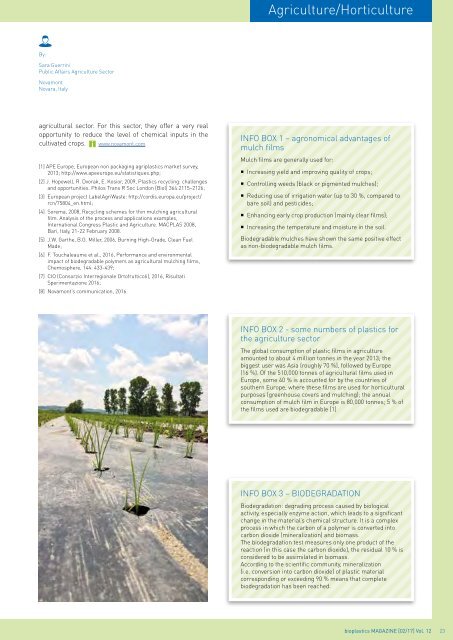Issue 02/2017
bioplasticsMAGAZINE_1702
bioplasticsMAGAZINE_1702
You also want an ePaper? Increase the reach of your titles
YUMPU automatically turns print PDFs into web optimized ePapers that Google loves.
Agriculture/Horticulture<br />
By:<br />
Sara Guerrini<br />
Public Affairs Agriculture Sector<br />
Novamont<br />
Novara, Italy<br />
agricultural sector. For this sector, they offer a very real<br />
opportunity to reduce the level of chemical inputs in the<br />
cultivated crops. www.novamont.com<br />
[1] APE Europe, European non packaging agriplastics market survey,<br />
2013; http://www.apeeurope.eu/statistiques.php;<br />
[2] J. Hopewell, R. Dvorak, E. Kosior, 2009, Plastics recycling: challenges<br />
and opportunities. Philos Trans R Soc London [Biol] 364:2115–2126;<br />
[3] European project LabelAgriWaste: http://cordis.europa.eu/project/<br />
rcn/75804_en.html;<br />
[4] Sorema, 2008, Recycling schemes for thin mulching agricultural<br />
film. Analysis of the process and applications examples,<br />
International Congress Plastic and Agriculture. MACPLAS 2008,<br />
Bari, Italy, 21-22 February 2008.<br />
[5] J.W. Garthe, B.G. Miller, 2006, Burning High-Grade, Clean Fuel<br />
Made;<br />
[6] F. Touchaleaume et al., 2016, Performance and environmental<br />
impact of biodegradable polymers as agricultural mulching films,<br />
Chemosphere, 144: 433-439;<br />
[7] CIO (Consorzio Interregionale Ortofrutticoli), 2016, Risultati<br />
Sperimentazione 2016;<br />
[8] Novamont’s communication, 2016.<br />
INFO BOX 1 – agronomical advantages of<br />
mulch films<br />
Mulch films are generally used for:<br />
• Increasing yield and improving quality of crops;<br />
• Controlling weeds (black or pigmented mulches);<br />
• Reducing use of irrigation water (up to 30 %, compared to<br />
bare soil) and pesticides;<br />
• Enhancing early crop production (mainly clear films);<br />
• Increasing the temperature and moisture in the soil.<br />
Biodegradable mulches have shown the same positive effect<br />
as non-biodegradable mulch films.<br />
INFO BOX 2 - some numbers of plastics for<br />
the agriculture sector<br />
The global consumption of plastic films in agriculture<br />
amounted to about 4 million tonnes in the year 2013; the<br />
biggest user was Asia (roughly 70 %), followed by Europe<br />
(16 %). Of the 510,000 tonnes of agricultural films used in<br />
Europe, some 40 % is accounted for by the countries of<br />
southern Europe, where these films are used for horticultural<br />
purposes (greenhouse covers and mulching); the annual<br />
consumption of mulch film in Europe is 80,000 tonnes; 5 % of<br />
the films used are biodegradable [1]<br />
INFO BOX 3 – BIODEGRADATION<br />
Biodegradation: degrading process caused by biological<br />
activity, especially enzyme action, which leads to a significant<br />
change in the material’s chemical structure. It is a complex<br />
process in which the carbon of a polymer is converted into<br />
carbon dioxide (mineralization) and biomass.<br />
The biodegradation test measures only one product of the<br />
reaction (in this case the carbon dioxide), the residual 10 % is<br />
considered to be assimilated in biomass.<br />
According to the scientific community, mineralization<br />
(i.e. conversion into carbon dioxide) of plastic material<br />
corresponding or exceeding 90 % means that complete<br />
biodegradation has been reached.<br />
bioplastics MAGAZINE [<strong>02</strong>/17] Vol. 12 23


















